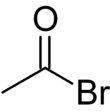Acetyl bromide
Acetyl bromide is an acyl bromide compound. As is expected, it may be prepared by reaction between phosphorus tribromide and acetic acid:[2]
- 3 CH3COOH + PBr3 → 3 CH3COBr + H3PO3
| |||
| Names | |||
|---|---|---|---|
| Preferred IUPAC name
Acetyl bromide | |||
| Identifiers | |||
CAS Number |
|||
3D model (JSmol) |
|||
| ChemSpider | |||
| ECHA InfoCard | 100.007.329 | ||
| EC Number |
| ||
PubChem CID |
|||
| RTECS number |
| ||
| UNII | |||
| UN number | 1716 | ||
CompTox Dashboard (EPA) |
|||
InChI
| |||
SMILES
| |||
| Properties | |||
Chemical formula |
C2H3BrO | ||
| Molar mass | 122.949 g·mol−1 | ||
| Density | 1.663 g/mL | ||
| Melting point | −96 °C (−141 °F; 177 K) | ||
| Boiling point | 75 to 77 °C (167 to 171 °F; 348 to 350 K) | ||
| Hazards | |||
| Safety data sheet | ILO MSDS | ||
| GHS pictograms |  | ||
| GHS Signal word | Danger | ||
GHS hazard statements |
H314 | ||
GHS precautionary statements |
P260, P264, P280, P301+330+331, P303+361+353, P304+340, P305+351+338, P310, P321, P363, P405, P501 | ||
| Flash point | 110 °C (230 °F; 383 K) | ||
Except where otherwise noted, data are given for materials in their standard state (at 25 °C [77 °F], 100 kPa). | |||
| Infobox references | |||
As usual for an acid halide, acetyl bromide hydrolyzes rapidly in water, forming acetic acid and hydrobromic acid. It also reacts with alcohols and amines to produce acetate esters and acetamides, respectively.
References
- Acetyl bromide at Sigma-Aldrich
- Theodore M. Burton and Ed. F. Degering (1940). "The Preparation of Acetyl Bromide". J. Am. Chem. Soc. 62: 227. doi:10.1021/ja01858a502.

